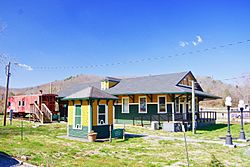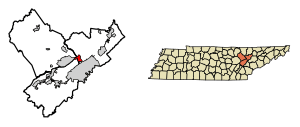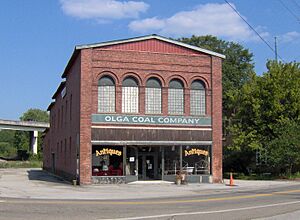Oliver Springs, Tennessee facts for kids
Quick facts for kids
Oliver Springs, Tennessee
|
|
|---|---|

Oliver Springs Depot, now the Oliver Springs Library
|
|

|
|
| Country | United States |
| State | Tennessee |
| Counties | Anderson, Roane, Morgan |
| Founded | 1821 |
| Incorporated | 1903 |
| Named for | Richard Oliver (early postmaster) |
| Area | |
| • Total | 5.78 sq mi (14.96 km2) |
| • Land | 5.78 sq mi (14.96 km2) |
| • Water | 0.00 sq mi (0.00 km2) |
| Elevation | 902 ft (275 m) |
| Population
(2020)
|
|
| • Total | 3,297 |
| • Density | 570.91/sq mi (220.45/km2) |
| Time zone | UTC-5 (Eastern (EST)) |
| • Summer (DST) | UTC-4 (EDT) |
| ZIP code |
37840
|
| Area code(s) | 865 |
| FIPS code | 47-55800 |
| GNIS feature ID | 2407045 |
Oliver Springs is a town located in Tennessee, a state in the United States. It is unique because it spreads across three different counties: Anderson, Morgan, and Roane. In 2010, about 3,231 people lived there. Oliver Springs is part of the larger Harriman, Tennessee Micropolitan Statistical Area, which includes Roane County. This area is a group of cities and towns that are connected economically.
Contents
History of Oliver Springs
Oliver Springs was first settled in 1821. It was originally called Winter's Gap. The town was named after Major Moses Winters. He was one of the first European settlers to arrive in the area. He had settled there before 1799.
Native American History and Healing Waters
Long before European settlers arrived, the area was used by Native Americans. They used it as a hunting ground and a place to set up camps. The natural mineral springs and lots of wildlife on Windrock Mountain made it a good place to stay. The springs were famous for their healing powers. This belief lasted until the 1900s. In the Cherokee language, these springs were called Tah-hah-lehaha, which means "healing waters."
European explorers first came to this land in 1761. An expedition led by Elisha Walden explored the Clinch and Powell River valleys. However, many settlers did not start moving here until the 1790s. Even then, the town grew slowly.
How Oliver Springs Got Its Name
In 1826, Richard Oliver became the town's first postmaster. The town was then renamed Oliver's Springs in his honor. For a short time, it was called Poplar Springs. Later, its name became Oliver Springs. Richard Oliver ran the mail service from his large 35-room mansion. This mansion also served as an inn for travelers.
Oliver was the first person to see how the mineral springs could be used for business. He would take his guests between the springs and his inn. During the Civil War, his inn was used as a hospital. Both sides of the war used it to care for their injured soldiers.
A Popular Resort Town
Joseph Richards bought Oliver's land in 1873. He built the first resort hotel there. In 1894, he replaced it with a much bigger hotel. This new hotel had 150 rooms and modern features for its time. Oliver Springs became a very popular resort town. The Oliver Springs Hotel welcomed rich guests. They came from all over the U.S. and Europe. They visited to drink the special waters and bathe in the springs. In 1888, a railroad line reached Oliver Springs. This made it even easier for thousands of visitors to come to the springs.
Sadly, the hotel burned down in 1905. The town decided to cover the springs instead of rebuilding the hotel. You can still see signs of the old water pipes and storage areas today.
Coal Mining and World War II
Oliver Springs was also a base camp during the Coal Creek War in the 1890s. This was a conflict about coal mining. In the early 1900s, the area's economy depended on the coal industry. For example, the Windrock Coal and Coke Company started a coal mine near Oliver Springs around 1904.
In 1942, during World War II, the U.S. government bought land nearby. They built a secret city called Oak Ridge. This was part of the Manhattan Project, which developed the atomic bomb. During this time, the Dr. Fred Stone Sr. Hospital was built in Oliver Springs. Dr. Fred Stone worked as a doctor for new Manhattan Project employees. Over time, Oliver Springs' economy relied on jobs in Oak Ridge. When jobs decreased after the Cold War in the early 1990s, the town faced challenges.
Modern Oliver Springs
After the Cold War, Oliver Springs and its nearby towns worked to find new ways to support their economies. Oliver Springs has tried different industries. In the late 1990s, the movie October Sky was filmed in the local coal mining areas and downtown. Today, the town is using its mountains to attract visitors. The mountains are very popular with people who ride all-terrain vehicles (ATVs).
Geography of Oliver Springs
Oliver Springs covers about 14.4 square kilometers (5.78 square miles) of land. There is no water within the town's boundaries. The town is located where two major land regions meet. These are the Ridge-and-Valley Appalachians and the Cumberland Plateau. Walden Ridge is a mountain ridge that marks the border between these two areas. You can see it just beyond the hills near the town. The Crab Orchard Mountains are part of the Cumberland Mountains. They rise on the Cumberland Plateau just west of Oliver Springs.
Population Information
| Historical population | |||
|---|---|---|---|
| Census | Pop. | %± | |
| 1890 | 643 | — | |
| 1910 | 700 | — | |
| 1920 | 777 | 11.0% | |
| 1930 | 660 | −15.1% | |
| 1940 | 855 | 29.5% | |
| 1950 | 1,089 | 27.4% | |
| 1960 | 1,163 | 6.8% | |
| 1970 | 3,405 | 192.8% | |
| 1980 | 3,659 | 7.5% | |
| 1990 | 3,433 | −6.2% | |
| 2000 | 3,303 | −3.8% | |
| 2010 | 3,231 | −2.2% | |
| 2020 | 3,297 | 2.0% | |
| Sources: | |||
2020 Census Details
| Race | Number | Percentage |
|---|---|---|
| White (non-Hispanic) | 2,964 | 89.9% |
| Black or African American (non-Hispanic) | 98 | 2.97% |
| Native American | 12 | 0.36% |
| Asian | 6 | 0.18% |
| Other/Mixed | 152 | 4.61% |
| Hispanic or Latino | 65 | 1.97% |
According to the 2020 United States census, Oliver Springs had 3,297 people living there. There were 1,616 households and 1,046 families in the town.
Education in Oliver Springs
The schools in Oliver Springs are managed by the three counties the city is part of.
- Anderson County:
- Norwood Elementary School (Kindergarten to 5th grade)
- Norwood Middle School (6th to 8th grade)
- Clinton High School (9th to 12th grade)
- Morgan County
- Coalfield School (Kindergarten to 12th grade)
- Roane County:
- Dyllis Springs Elementary School (Kindergarten to 5th grade)
- Oliver Springs Middle School (6th to 8th grade)
- Oliver Springs High School (9th to 12th grade)
The Oliver Springs Railroad Depot was built in 1896. It was restored recently. Now, it is home to the Oliver Springs Public Library. Besides books, the library also keeps the city's historical records. These records were first collected by Snyder E. Roberts.
See also
 In Spanish: Oliver Springs (Tennessee) para niños
In Spanish: Oliver Springs (Tennessee) para niños


